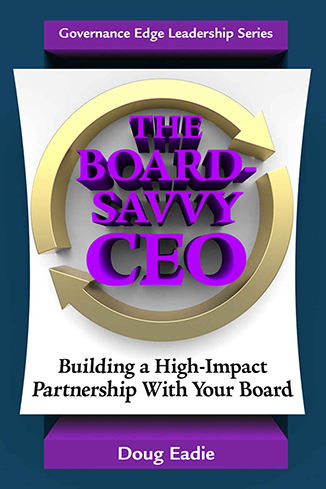 A few months ago I sat in on a meeting of the board planning committee of a nonprofit economic development corporation. We were running through an outline of the agenda for the corporation’s upcoming board-CEO-executive team daylong “strategic work session,” which would kick-off the corporation’s annual planning cycle. Things were going really smoothly until we got to the description of the breakout group that was to fashion an updated vision statement for the corporation. Three of the seven committee members immediately went on the attack. One pointed out that the values and vision statements that’d been updated in a retreat four years earlier hadn’t made the least difference so far as she could tell; in fact she wasn’t even certain she could put her hands on them. “Pure fluff” was her assessment. The other two spent fully ten minutes talking about how much time they’d wasted in that that earlier retreat, “wordsmithing” the one-paragraph vision. One of them called it an “excruciatingly painful” experience he wasn’t about to put himself through again.
A few months ago I sat in on a meeting of the board planning committee of a nonprofit economic development corporation. We were running through an outline of the agenda for the corporation’s upcoming board-CEO-executive team daylong “strategic work session,” which would kick-off the corporation’s annual planning cycle. Things were going really smoothly until we got to the description of the breakout group that was to fashion an updated vision statement for the corporation. Three of the seven committee members immediately went on the attack. One pointed out that the values and vision statements that’d been updated in a retreat four years earlier hadn’t made the least difference so far as she could tell; in fact she wasn’t even certain she could put her hands on them. “Pure fluff” was her assessment. The other two spent fully ten minutes talking about how much time they’d wasted in that that earlier retreat, “wordsmithing” the one-paragraph vision. One of them called it an “excruciatingly painful” experience he wasn’t about to put himself through again.
I wasn’t the least bit surprised or taken aback. I can’t tell you how many board members I’ve heard recount similar experiences over the years, and I must say that I’ve almost always agreed with their assessment that they’d wasted precious time in retreats meticulously crafting brief (typically two or three sentences at most) slogan-like vision statements that ultimately made little difference and were typically soon forgotten. The existing vision statement of the economic development corporation was a classic example – a one-sentence slogan masquerading as a vision: “We will be our region’s preeminent economic development organization and a powerful job creation engine that works in close partnership with the public and private sectors.”
It’s not that a vision statement isn’t important; it’s extremely critical, but only if it’s specific enough to serve as a serious educational and planning tool. For example, the board and executive team of the economic development corporation I’ve been talking about eventually developed an updated “Impact Vision” by identifying 12 key regional outcomes/impacts it aspired to produce over the long run in a number of broad impact-areas, including: business mix; job growth; average wages; tax base; national image; quality of life; public-private collaboration; etc.
On the educational front, a detailed vision statement provides clients/customers, employees, the general public, key stakeholders and funders such as government departments and foundations with a very clear picture of what your organization is all about – what makes it unique and distinguishes it from other organizations in your environment, and also what justifies funding its activities. On the planning front, a detailed vision statement serves as a driver of long-term strategic change, by helping your organization identify strategic issues – defined in terms of opportunities to make progress on specific vision elements (for example, applying for a major grant or launching a new program) and of challenges standing in the way of achieving particular vision elements (for example, a declining revenue source or a seriously tarnished image). Once your board and executive team – usually in a retreat setting – have identified what appear to be the preeminent issues facing your organization, then you can winnow them down to the short list of issues that merit attention now (which means fashioning change initiatives to address the selected issues). You can easily see why visioning is often called the “gold standard” for board involvement in leading change.
What about public relations, you might be asking? Well, in my experience, there’s nothing wrong with coming up with an abbreviated version of your detailed vision statement – a pithy paragraph or even a one-sentence slogan – for inspirational and promotional purposes. Just don’t make the common mistake of mixing PR up with serious education and strategic change.





